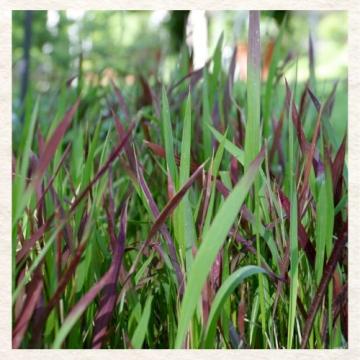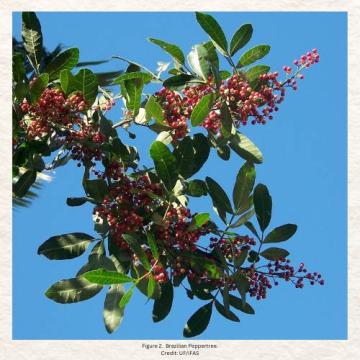Invasive species pose a serious threat to Florida's ecosystems, affecting water quality and native habitats, plants and animals. Learn more below about the main invasive species in Florida, which include invasive aquatic and terrestrial plants and animals such as feral hogs and the methods used to control their spread.
Aquatic Invasive Plants
Common aquatic invasive plants, such as hydrilla, water hyacinth and water lettuce, significantly impact ecosystems by hindering water flow, reducing oxygen levels and disrupting native habitats. These species can outcompete native plants, negatively affect fish populations and interfere with human activities like boating and fishing.
Methods used to control these invasives include mechanical harvesting to physically remove the plants, chemical treatments using herbicides to manage growth and biological control by introducing natural predators like grass carp to keep plant populations in check. Click for more information on invasive aquatic plants.
More on Invasive Aquatic Plants: Hydrilla
Hydrilla, an invasive aquatic plant, thrives in Florida’s water bodies due to its efficient photosynthesis process, allowing it to rapidly convert nutrients and carbon dioxide into growth. This advantage enables hydrilla to outcompete native species, forming dense mats on the water surface that block sunlight, deplete oxygen and disrupt ecosystems. These mats reduce biodiversity, create breeding grounds for mosquitoes and interfere with recreational activities like boating and fishing. Effective management combines mechanical, chemical and biological methods, with strategies tailored to hydrilla's growth patterns. For more information, visit the UF/IFAS blog.
Invasive Terrestrial Plants
Invasive species pose a significant threat to ecosystems around the world, disrupting habitats and outcompeting native flora and fauna. Understanding and managing these invasive plants is crucial for maintaining biodiversity and ecological balance. Below we will explore several prominent invasive species, in the state of Florida including the Melaleuca tree, Cogongrass, the Old World climbing fern and Brazilian pepper trees. Each of these species presents unique challenges and requires targeted control strategies to mitigate their impact. Learn about the various methods used to manage these invasives and how ongoing research and community efforts contribute to restoring and preserving our natural environments. Visit the Center of Aquatic and Invasive Plants for even more information.
Old World Climbing Fern
Old World climbing fern, a vine native to Africa, Asia and Australia, was first found in south Florida in the late 1950s. It forms dense mats that can kill trees, shrubs and plants, degrading wildlife habitats. The vine is flammable and can carry fire into normally fire-resistant wetland areas, causing fires to reach treetops and potentially kill even fire-tolerant trees. It is spreading northward from south Florida and has been detected and treated as far north as Hernando and Sumter counties. This invasive species poses a significant threat to the integrity of natural ecosystems, necessitating ongoing management efforts. Researchers are exploring additional control methods to curb its rapid spread and mitigate its environmental impact.
Cogongrass
Cogongrass, a warm-season perennial grass, is considered one of the world's worst invasive plants. In the U.S., it is found in Virginia, North Carolina, South Carolina, Georgia, Florida, Alabama, Mississippi, Louisiana, Texas and Oregon. Accidentally introduced near Mobile, Alabama, in 1912 via crate packing material, it was later intentionally brought from the Philippines to Mississippi as a forage crop in 1921 and replanted in Florida in the 1930s for forage and soil stabilization. Despite these efforts, it proved inadequate for forage and quickly became a widespread pest. Its aggressive growth outcompetes native vegetation, posing a significant threat to biodiversity and ecosystem health.
The Melaleuca Tree
The Melaleuca tree drains wetlands and displaces native species, leading to reduced biodiversity and altered fire patterns. Control methods include physical removal, herbicides and biological control agents like the Melaleuca snout beetle. These efforts are crucial to restoring natural habitats and preventing further ecological damage. Ongoing research aims to improve the efficiency and sustainability of these control methods. Public awareness campaigns and community involvement are also essential in managing this invasive species. Effective management of Melaleuca requires coordinated efforts between governmental agencies, scientists and local stakeholders.
Brazilian Peppertree
Dense clusters of Brazilian pepper trees overwhelm native vegetation, disrupting habitats and creating unsuitable conditions for wildlife. These trees form dense thickets that block sunlight and water, hindering the growth of other plants. Effective control methods involve mechanical removal, such as cutting and digging out the trees and the use of herbicides to prevent their regrowth. For more information, visit the UF/IFAS blog.
Invasive Animals
Feral hogs disrupt ecosystems and agriculture through rooting, which damages soil structure, causes erosion and harms native plants and crops. They have a high reproductive rate and are found in various habitats with water resources. They compete with native wildlife for food and habitat and spread diseases. Control methods used include organized hunts, baited traps and exclusion fencing to protect sensitive areas. Managing feral hog populations is crucial to mitigate their extensive environmental and economic damage. Click here for our FAQ on Feral Hogs.
Protecting Florida’s Ecosystems: Combating Invasive Species Together
Invasive species pose a significant threat to Florida's ecosystems, impacting water quality, native habitats and biodiversity. Both aquatic and terrestrial invasive plants, such as hydrilla, water hyacinth, Brazilian pepper tree, melaleuca tree and Australian pine, as well as invasive animals like feral hogs, require vigilant management to control their spread. Effective control methods include mechanical removal, chemical treatments, biological control and community involvement. By working together and implementing these strategies, we can protect Florida's natural beauty and ecological health, ensuring a balanced and thriving environment for future generations.
The District's treatment schedule can be found on the FWC Treatment Schedule website. Scheduled operations may be cancelled due to unfavorable weather or environmental conditions, or manpower and equipment availability. For additional information, please call 1-800-423-1476 (FL only) or (352) 796-7211.







